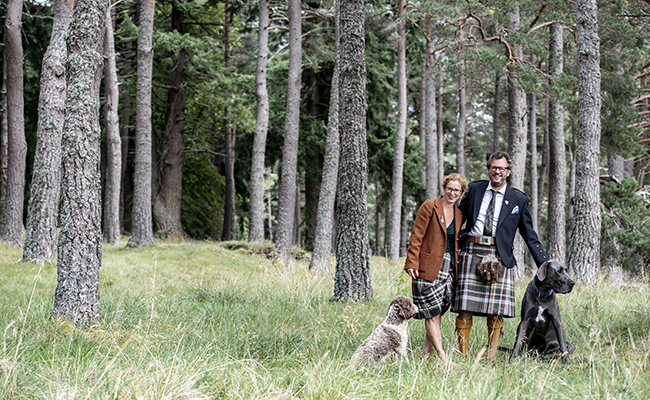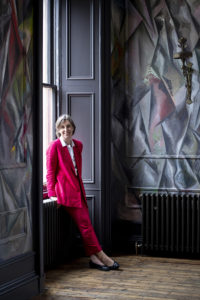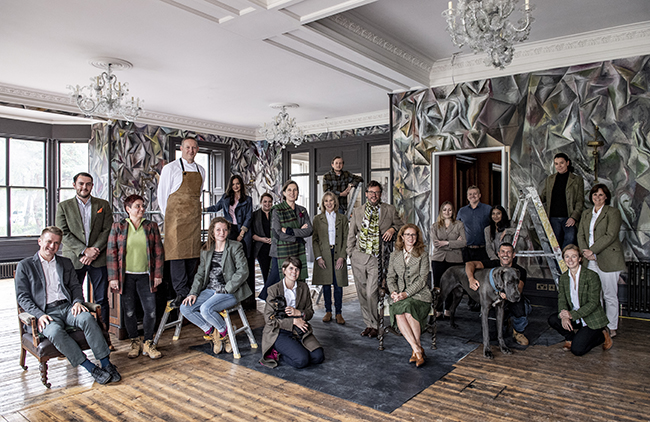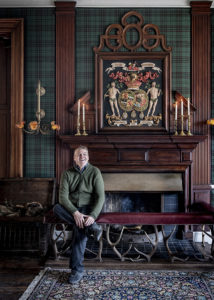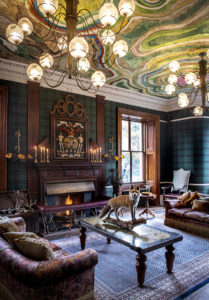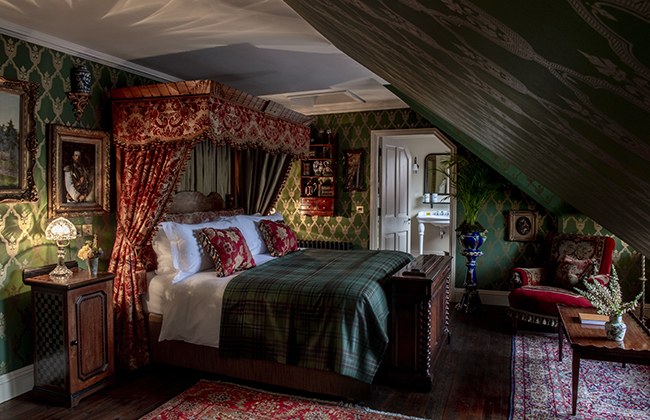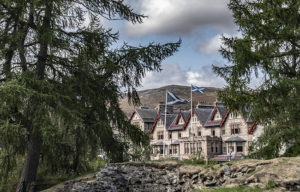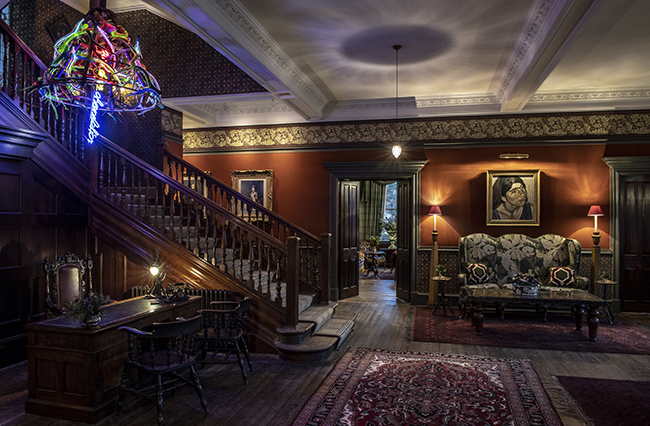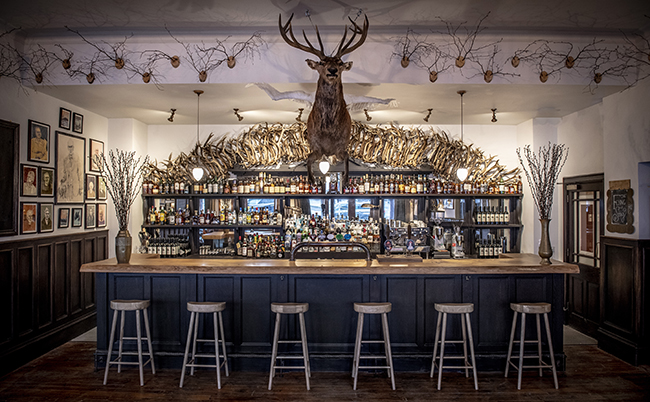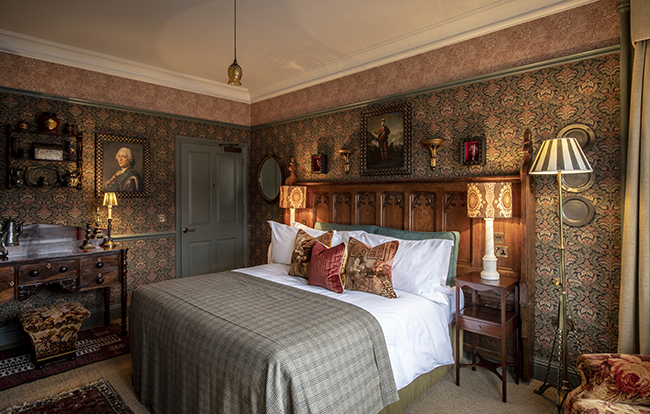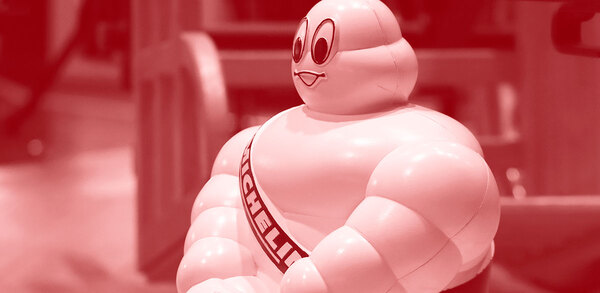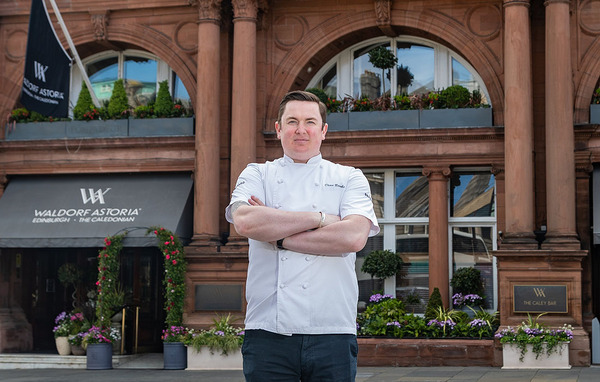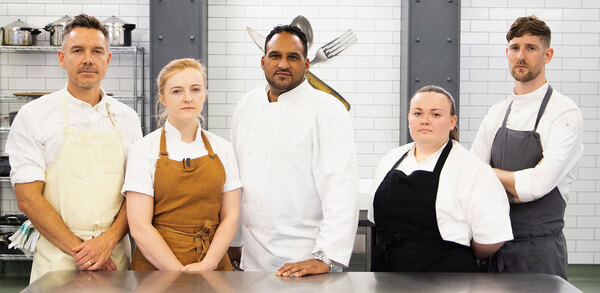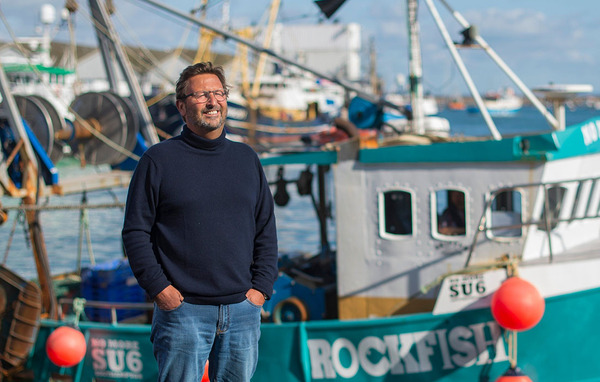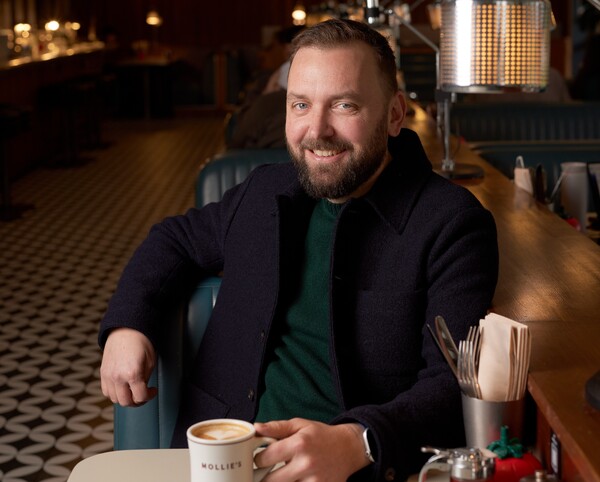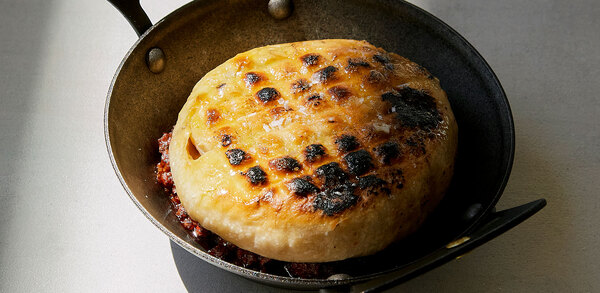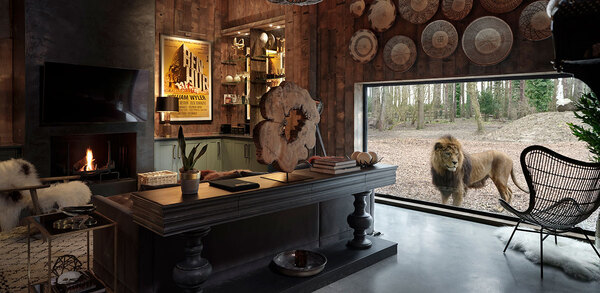Picture perfect: Art meets hospitality at Iwan and Manuela Wirth's Fife Arms
Art power couple Iwan and Manuela Wirth have transformed the Fife Arms in the heart of the Scottish Highlands from a tired, run-down property into a world-class venue showcasing the most impressive collection of art ever gathered in one hotel. Janet Harmer checks in
Discovering paintings by Pablo Picasso and Lucian Freud hanging in the public spaces of a hotel would be surprising in any location around the world, but to find them within a property in a sleepy village in the midst of the Scottish Highlands is quite extraordinary.
Indeed, the story behind the reopening of the 46-bedroom Fife Arms in Braemar, just a few minutes from the Queen's residence at Balmoral, is unexpected. Originally built as a hunting lodge by the Duke of Fife, the solid granite Victorian building is located at the heart of the village and over the past four years has been undergoing something of a renaissance.
Until 2014, the Fife Arms was owned by coach holiday company Shearings and predominately accommodated touring parties travelling through the Highlands. Then along came two of the most influential personalities in the contemporary art world, Iwan and Manuela Wirth. The couple, who topped the 2015 Power 100 list compiled by magazine ArtReview in recognition of their two galleries in Somerset and London, as well as seven overseas, are a force with which to be reckoned.
Alongside moving between their main home in Somerset and one in their home nation of Switzerland, they also like to spend time at their baronial-style property in Braemar, the renowned venue of Scotland's most prestigious Highland games, the annual Braemar Gathering attended by the Royal Family.
"Braemar is very much our happy place," Iwan tells The Caterer. "After carrying out an extensive renovation on our home here, we decided to buy the Fife Arms as we could see the magic in the property. However, if we had known now what we found out about its true condition, we might have never gone ahead."
"I have travelled to some 60 countries all over the world and regard the Cairngorms as one of the top 10 places for stunning scenery," says Iwan. "I have also stayed in some incredible hotels and we knew that the Fife Arms in this setting could become one of those most incredible places on the planet."
Straight to work
Soon after acquiring and then closing the property, the Wirths set about gathering together some of the most renowned names in the business to help them realise their vision, appointing Federica Bertolini as general manager and Russell Sage as interior designer to lead the way. While Bertolini and Sage came from further afield, locally based Moxon Architects, run by Ben Addy and his building contractor brother Tom, provided a connection to the region. Other big names included Chelsea Flower Show award-winner Jinny Blom, who designed the garden, and Araminta Campbell, who created the bespoke house tartan and tweed.
In a highly unusual move, Bertolini moved to the Fife Arms in October 2015, more than three years before the reopening of the hotel two weeks ago. For Iwan, it was absolutely essential that Bertolini was on board from the early days of the project.
"Whenever we open a new gallery, one of the first things we do is hire a manager," he says. "We wanted to do the same at the hotel – we didn't want a cold start. It was a big lifestyle change for Federica and she has had time to settle in and make a real connection to the community. She has been able to fly."
The move for Bertolini within the UK could not have been much greater. Prior to heading to the Highlands, she spent 11 and a half years as general manager at Olga Polizzi's Hotel Tresanton in St Mawes, Cornwall, which Iwan says stood her in good stead for her new role. "The Tresanton is in the middle of nowhere, just like the Fife Arms."
Bertolini arrived in Braemar with the experience of attracting staff to a remote location and providing extensive accommodation for a team, as well as knowing how a seasonal business operates and the intricacies of working alongside an owner with the highest standards when it comes to the aesthetics of the building.
It is not the first time that Bertolini has worked in Scotland. She and her husband first moved to the country from their native Italy in 1997. When Bertolini was appointed as a receptionist at the Balmoral hotel at Edinburgh the following year, her only previous hospitality experience had been working on a campsite. Over the next three years, she worked her way up to front office assistant manager, before returning to Italy to Hotel de Russie in Rome, the Balmoral's sister property within Rocco Forte Hotels.
As personal assistant to the Hotel de Russie's general manager, Matthew Dixon (now chief commercial officer for Corinthia Hotels), Bertolini was swiftly propelled into a management environment, as her boss did not speak Italian. After Rome came the leap to St Mawes in 2004 when Polizzi (Sir Rocco Forte's sister) was looking for a general manager, a role which she recalls fondly. "The Tresanton was the opposite of a corporate environment; it was a hotel that operated with spontaneity and genuineness. When I was approached about the Fife Arms, I could see that was going to be the same here. I think I got the job because Iwan and Manuela could see that I was not a traditional GM."
It is clear that Bertolini is very much the heart and soul of the Fife Arms. She has embedded herself in the local culture and has successfully created the family-style environment that the Wirths have encouraged among the 90-strong team, two-thirds of whom live in staff accommodation. "There is a lot of warmth, care and friendliness here; Iwan and Manuela understand that the staff spend a lot of time at work and they need to be inspired when they are here."
A work of art
Much of the inspiration is engendered by the staff simply being immersed in a building that is packed full of exceptional pieces of art. Every piece has a story to tell and, as a result, a key part of the staff training programme ahead of the opening involved talks from historians and Sage, to provide an understanding of the items on display. "The hotel is visually and intellectually challenging and guests will be asking questions," says Bertolini. "There is so much the staff need to know to inform guests and they love it – it adds another dimension to their work."
Sage, whose previous work has included London's Goring hotel and the Zetter Townhouse, describes the Fife Arms as a once-in-a-lifetime opportunity. "I can't imagine I will ever work on a project like this again," he says. The intention was to create a hotel where art was an integral part of the property, but ensuring it complemented the historic interior.
"Every room is layered. In a traditional hotel, you may take a painting and choose a colour from that painting to inform the room palate. Everything here is so much more than that. Take the drawing room with tartan on the walls, a mural on the ceiling, works of arts from Picasso and Archibald Thorburn: there are so many unexpected elements which feel as though they have been built up over time.
"We have done things to promote excitement and curiosity. It has been a restoration with the dials turned up."
Of course, one of the major challenges of a property featuring so many individual artefacts and where the bedrooms are all individually designed is how the hotel will be kept dust-free at all times. "The housekeeping team has embraced the hotel in a positive way," says Bertolini. "It is taking longer to clean each room, but that is because the owners like to think of it as a home rather than a hotel."
The value of the art on display is undoubtedly immense, as is the cost of the refurbishment – neither of which will be revealed by the Wirths – but Iwan assures that security measures are in place to ensure the artwork is kept safe.
The future of Fife
While the Fife Arms is not the Wirths' first hospitality venture – the Roth Bar & Grill, Durslade Farmhouse and the Bull Inn at Hardway operate alongside their galley in Bruton, Somerset, and the Manuela restaurant is situated within the Los Angeles' gallery – the hotel is the first of what could become a collection. A second, the Invercauld Arms, just a stone's throw from the Fife Arms, has already been acquired.
Also previously owned by Shearings, the property came the Wirths' way sooner than they had intended, but Iwan admits it has proved invaluable in accommodating the pre-opening team and the Fife Arms staff. Additional properties are in the process of being bought in Braemar and Ballater (16 miles away) for staff, to free up the Invercauld Arms, ready for its own refurbishment.
"We are developing the concept for the Invecauld Arms," explains Iwan. "It will be complimentary to the Fife Arms and at a lower price point. The guests will probably be more sporty and the art will be more contemporary. Fife is the full Scottish experience. The Invercauld will not quite be the vegan sister, but there won't be a single dead animal on display."
The Fife Arms will undoubtedly attract guests with deep pockets, but Iwan hopes that it will appeal to a cross-section of people, from the backpacker who will book one of the smaller rooms to the vintage Ferrari driver who will want to check in to the premium suite.
"Anyone who feels the energy, beauty and romanticism of the Highlands will want to come here," Iwan explains. "The best hospitality is created by hotels that welcome a broad range of guests."
Contact and details
The Fife Arms
Mar Road, Braemar, Aberdeenshire AB35 5YN
01339 720200 www.thefifearms.com
Owners Iwan and Manuela Wirth
General manager Federica Bertolini
Executive chef Robert Cameron
Bedrooms 46
Food and beverage The Clunie Dining Room, Elsa's Bar, the Flying Stag pub, Albamhor spa, and shop
Rates From £250 for bedrooms and from £795 for suites, all including breakfast
Art at the Fife Arms
It has been a mammoth task to gather together some 12,000 exceptional artefacts, antiques and artworks for the Fife Arms. In addition to those selected by Iwan and Manuela Wirth and Russell Sage, there have also been two full-time members of staff working with Sage on sourcing pieces that have relevance and a connection to the Scottish Highlands, all of which are expected to remain in situ for some time. The exceptions are the two oil paintings, by Pablo Picasso (Mousquetaire assis, 1967) and Lucian Freud (Annie, 1962), which are on loan from private collections.
"The Picasso in particular has created a lot of interest; it has even brought in parties of schoolchildren," said Iwan. "It is unusual to see a Picasso on public display in Scotland.
"Art should be shared and I hope people will come into the hotel to see the displays and perhaps have a cup of tea or a dram at the bar."
Iwan says that the only comparable hospitality businesses that hold such extensive works of art are two of his favourite restaurants: Kronenhalle in Zurich and Colombe d'Or in St Paul-de-Vence, Provence.
The hotel is a visual feast, with Victorian artworks happily sitting alongside bespoke commissions from contemporary artists such as Zhang Enli from China, who has created a mural on the ceiling of the drawing room depicting the topography of the surrounding landscape, and Guillermo Kuitca, who is responsible for the abstract mural featuring a tributary of the River Dee on the walls of the Clunie Dining Room.
Elsewhere, various bespoke chandeliers inject fun and modernity with a rift on the Scottish tradition of antler displays: one incorporates hundreds of antlers, ethically sourced by Gareth Guy of the Horn Shop in Braemar, and the other is from American artist Richard Jackson, featuring a collection of jewel-coloured glass antlers, providing a focal point at the centre of the main staircase.
Gideon Summerfield, a recent postgraduate of London's Royal School of Drawing, has produced a series of portraits of many of Braemar's 450 residents. The artworks hang in the Flying Stag pub, providing the clearest message from the owners of their desire to share the transformation of the building with the local community.
There are also a number of paintings dating back to the early days of the Alexander Marshall Mackenzie-designed property, including a watercolour of a stag's head painted by Queen Victoria. Most notably, there is one of the largest collection of art by Archibald Thorburn, the renowned animal painter and bird illustrator, on display throughout the hotel.
"We were a bit lucky to get the Thorburns – we got them when we bought up about half of the collection from the Tillypronie Estate in Aberdeenshire, owned by the Astor family, at Sotheby's two years ago," explains Iwan. "The paintings depict the nearby grouse moors and surrounding areas and are an absolutely perfect fit for the Fife Arms."
In addition to the art, there are also hundreds of original pieces of Victorian furniture throughout the public spaces and 46 bedrooms, each named after a character, happening or place linked to Braemar. As guests check into the hotels, they are presented with a book containing their key and the background story to the artefacts in their room.
Sage says he is excited about "the little spaces" that can often be forgotten in hotels. "Here, they become an essential part of the story: be it the route of a small staircase between bedroom floors, showcasing 100 pieces of taxidermy; a corridor leading to a single bedroom, which has become a glorious private gallery; or the lift, which is now a pine cone grotto, assisted in its construction by the people of Braemar."



